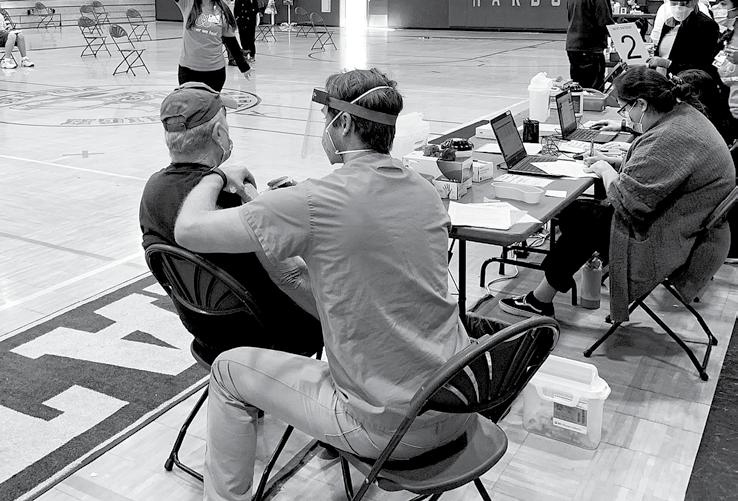
4 minute read
Sprout Up, By Edita McQuary County Enters Red COVID Tier, By Jondi Gumz
COMMUNITY NEWS County Enters Red COVID Tier
By Jondi Gumz
Advertisement
With the COVID-19 case rate plummeting, Santa Cruz County entered the less restrictive Red Tier on March 10, allowing restaurants, gyms and fitness centers, movie theaters and museums to open indoors for the first time since mid-November and retail stores and shopping center to increase capacity to 50 percent.
“The lines at Trader Joe’s should be shorter,” said Santa Cruz County Health Officer Dr. Gail Newel at a virtual press conference Thursday.
The new allowable capacity is 25 percent for theaters, museums, restaurants and places of worship and 10 percent for gyms and fitness centers.
Newel lifted her prohibition on visits at nursing homes and assisted living centers, allowing family members to see loved ones after restrictions aiming to prevent the contagious coronavirus from spreading kept them apart for a year.
As of March 13, the state began allowing wineries and breweries without meals to open outdoors with a 90-minute time limit and 8 p.m. close.
Starting April 1, the state is allowing outdoor live events at 20 percent capacity and amusement parks at 15 percent capacity.
As of June 1, the state will allow overnight sleep-away camps.
CineLux Capitola has already opened. The Santa Cruz Museum of Art & History announced plans to open to members first. Capitola Beach Co. announced plans to begin offering surf lesson and rentals on April 1. Santa Cruz Shakespeare announced plans for a small, safe outdoor live season in July and August. The folks at Arts Council Santa Cruz County announced plans to resume the Open Studios event in October.
Pajaro Valley Unified School District, which will begin hybrid instruction with in-person lessons for kindergarten April 5, announced that in-person instruction will resume earlier than planned, the week of April 12 for students in grades 2-6 and high school seniors. Students in grades 6-8 and 9-11 can return the week of April 19. Families can opt to continue distance learning if they wish.
“It’s very exciting for parents to get their children back to school,” Newel said, noting that all K-12 educators in the county have had an opportunity to receive their first dose of vaccine.
She urged everyone to get a vaccine once they are eligible and in the meantime, Dr. Andrew Smythe, of Dignity Health Medical–Dominican, vaccinates a community member at the Harbor High School vaccination site. wear masks and practice social distancing in public so as to protect unvaccinated elders and those who are medically vulnerable.
193 Have Died
COVID-19 has claimed the lives of 55,000 Californians and 193 Santa Cruz County residents, with 55 percent of those local deaths at nursing homes and assisted living facilities. Locally, 80 percent of those who died were age 70 or older and 77 percent had other health conditions.
A year after the pandemic began, case rates have plummeted across the state, and with 11 million vaccine does administered, 20 counties are in the Red Tier.
Santa Cruz County’s adjusted COVID case rate is 5.3 per day per 100,000, below the rate of 7 required for the Red Tier.
Newel said she anticipates moving to the Orange Tier by March 31.
The Orange Tier, which requires an adjusted case rate of 3.9 per day per 100,000, allows 25 percent capacity at gyms, dance studios, bowling alleys and climbing walls, and 50 percent at movie theaters, museums, restaurant and places of worship.
Newel said the state plans to change the metric for moving into less restrictive tiers, a change that will be “to our advantage.” she said, noting the B117 variant, which spreads more easily, hasn’t shown up yet.
On Friday, the county reported only seven people hospitalized with COVID, including two in intensive care, fewer than 300 active cases, and more than 119,000 negative test results.
Santa Cruz County ranks sixth in the state for vaccinations per capita, according to Mimi Hall, director of the county Health Services Agency.
Dr. David Ghilarducci, deputy health officer, said 111,000 doses have been given to county residents, 83 percent to those 75 and older, and 76 percent to those 65 and older.
It’s much lower for younger people, and that’s because the state requires 70 percent of doses go to people age 65 and up who are at greater risk of dying, 30 percent to people in riskier jobs – and 10 percent set aside for educational and child care workers.
Hall said she’s found slots reserved for people 65 and up “are not filling up” with Thursday an example with “a couple hundred slots” that had to be filled.
The county has moved from Phase 1A, healthcare workers and long-term care residents to Phase 1B, where 50,000 people working in agriculture, food service, education, child care, emergency services are eligible, but not all of them have been vaccinated.
State officials had emphasized a system based on age, so Newel was surprised when state officials said new job categories will be eligible for vaccines.
These include transit workers, airport staff, custodians, janitors and housekeepers, disaster service workers, utility workers responding to disasters. Also, individuals who are medically high risk, incarcerated, homeless, staff serving these populations and volunteers with MyTurn. ca.gov, the new app where people can register to find out when they can get a vaccine.
Supplies Limited
Being in a category that is newly vaccine eligible does not mean the vaccine is easy to get because supplies remain limited.
The OptumServe vaccine in Watsonville is only providing second doses in March due to limited supplies, but plans to restart first does in April, Ghilarducci said.
As of March 15, people age 16 to 64 with a certifiable risky health condition may be able to get a vaccination from their health care provider.
Again, Ghilarducci expects demand to exceed supply.
“COVID Update” page 15











